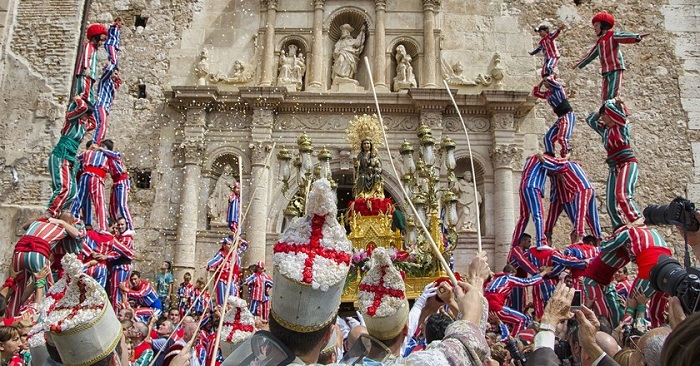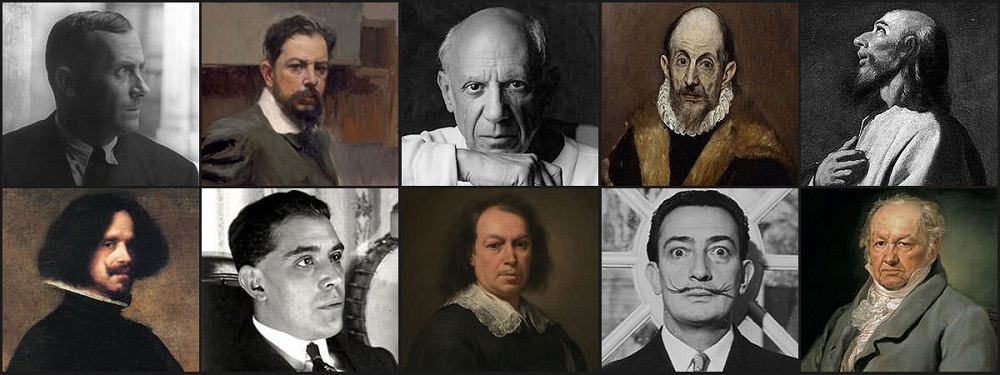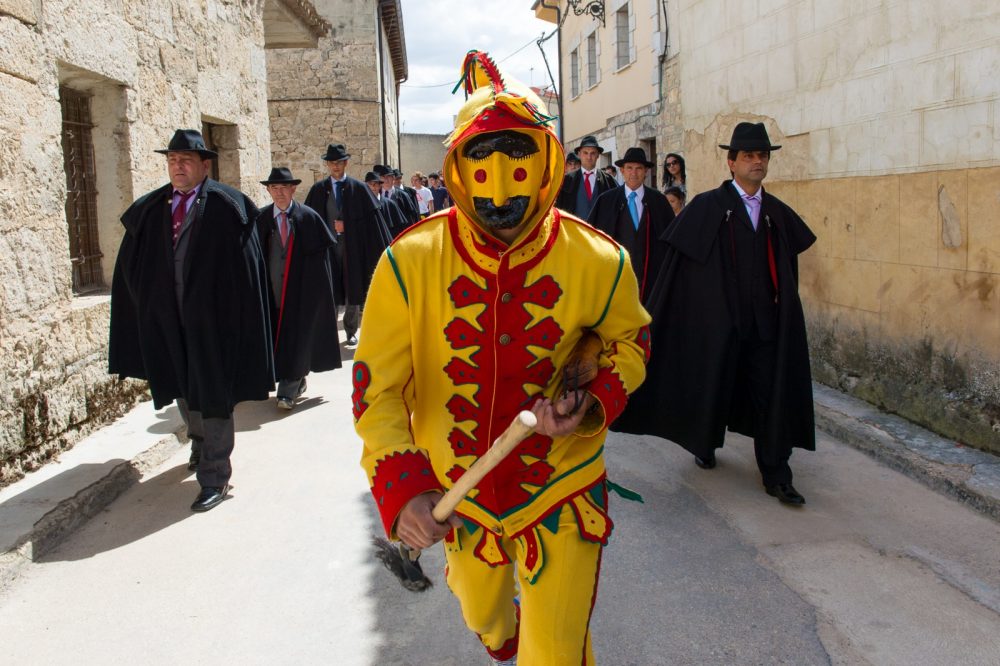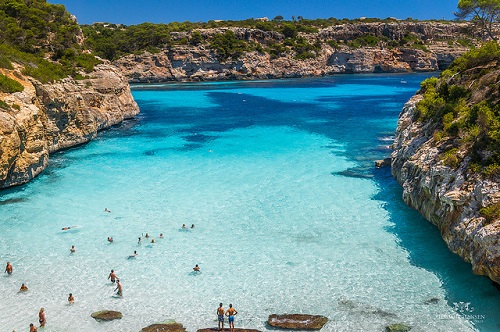The Festivity of ‘’la Mare de Déu de la Salut’’ celebrated at the beginning of September in the village of Algemesí a small town located 35 kilometers from the city of Valencia, Spain. In addition, every 7th and 8th September the streets and squares of Algemesi become the stage for a special cultural manifestation. besides, almost 1,400 people participate in theatre, music, dance and performances arranged in the historical areas of the city of Valencia, La Muntanya, Santa Barbara and La Capella.
History of La Mare de Déu de la Salut
 Via – Unesco
Via – Unesco
This celebration arises in Medieval times 1247 and has been held in Algemesí on the 7th and 8th September to great popular acclaim since then. The traditional ceremonial acts of the event have been passed from generation to generation and it contains dance, music (63 compositions), theatre and performances similar to the Christian, Moorish, Roman and Jewish cultures.
The music of the traditional Dolçaina, Tabal, the pieces for orchestra and timpani that supply musical accompaniment for the “Muixeranga” human tower and the dance performances of ‘’the Pastoretes”, “Bastonets, “Carxofa”, “llauradores, ‘’Arquets” and “Tornejants”, recreate and encourage a collective memory and transferring universal messages of highly artistic visual and aural sentiments.
All over the celebration, Algemesí becomes a living museum, monument to Valencian and Mediterranean traditions, also interlaced with the faith, tradition and culture of the ritual celebrations at the Basilica, besides, the soundscapes created by the ringing of the bells and the 17th Century surroundings along the routes of the parades which over 1400 people take part in.
Three big parades
 Via – Comunitatvalenciana
Via – Comunitatvalenciana
The festivity of ‘’la Mare de Déu de la Salut’’ divided into three important processions are celebrated in honor of Virgin of Health which fill the streets with colorful places and music playing performed by over 500 people.
Moreover, The first procession takes place on September 7th at 10 P.M is known as the ‘’the procession of promises’’, during the course of this parade the image of the Virgin is held from the Basilica, which is the main church in the town to the sanctuary, assembled in the place where the image was found.
The second one is ‘’Parade of the Morning’’ commemorated in the morning on Sept 8th, at 10 A.M It is the shortest of the three celebrations, but also the most extraordinary parade. Besides, with this procession the Virgin is taken back to the Basilica, but following a shorter way and all the houses along the itinerary ornament their balconies and there are colorful displays all around the city.
The last parade starts the same day at 8 P.M known as the ‘’Volta General’’ is the longest of the parades and it lasts for more than seven hours, until past 2 A.M. The Virgin goes across the town center and people wait in front of their houses to give a donation to the courtship in exchange of a dance. The parade ends, When the Virgin arrives again to the Basilica.
Characters and dancers
 Via – Venamicasa
Via – Venamicasa
The festivity of ‘’la Mare de Déu de la Salut’’ is a religious celebration represents the old Valencian traditions. This festivity is important for its mythological elements and more than anything because it has served to maintain different traditions of the area. Besides, this festivity comprised different groups of dancers which are the major elements of the celebration:
La Muixeranga: Are the most popular dancers because they build a huge human towers at different points in the itinerary. Also they lead the group and dressed in their blue-and-red or green-and-red costumes.
The Bastonets: they represent a typical battle dance fighting in a tuneful rhythm with their small sticks (Bastonets) by following the rhythm of the Tabalet and the Dolçaina.
La Carxofa: is a ceremonial Valencian dance played around a big cane with an artichoke on the top. The cane is placed in the middle and with the help of different ribbons the dancers move around it.
Els Arquets: a group of dancers dance to the beat of the Dolçaina and Tabalet, carrying small arches with bells that they use to follow the beat.
Les Pastoretes: are the next dancers to come. The dances, played by children, serve as an initiation process and give the chance to the young ones to participate in the celebration.
Les Llauradores: is considered as the most modern dance in the procession, started in 1906 this dance is not played with the music of the dolçaina and tabalet, but with different wind instruments. The dancers (men and women) dressed in the traditional Valencian costumes and playing the castanets.
The Gegants: a group that has been returned quite recently, goes after the Llauradores, but just after the ‘Morning Parade’. These dancers are two giant figures symbolizing King James I (the conqueror of the Valencian territories) and his wife Na Violant D’Hongria. The bearer inside them make the figures dance to the rhythm of the music, entertaining both the young and the adults.
Finally, Els Tornejants, is the last group of dancers called the knights of the Virgin as they go between the Mayor Cross and the image of the Virgin, wearing traditional soldier’s costumes to perform the battle dance and elaborate traditional choreography to music of kettledrums.
Altogether, these groups of dancers conceive a colorful and joyful ambience by creating an atmosphere in which the locals and visitors enjoy a unique show, filled with music, history and rhythm.
 Via – Comunitatvalenciana
Via – Comunitatvalenciana
In brief, The Fiestas of ‘’la Mare de Déu de la Salut’’ in Algemesi is a magnificent festival in which locals and visitors entertain dances and traditions of the Valencian people. The importance of the festivity in Algemesi lies in the way in which it still maintains the local traditions and keeps alive the originality and the uniqueness of the old Valencian spirit.


 Top 10 Most Famous Spanish Artists and their Arts
Top 10 Most Famous Spanish Artists and their Arts
 El Colacho, the Baby Jumping Festival in Murcia Spain
El Colacho, the Baby Jumping Festival in Murcia Spain
 Discover The Most Beautiful Places In Mallorca, Spain
Discover The Most Beautiful Places In Mallorca, Spain